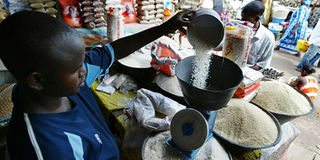Zero hunger is possible in Kenya by 2030

A trader measures and weighs rice for sale in a market. According to the report on the state of food security, hunger is significantly worse in countries with rain-fed, low technology agricultural systems that are highly sensitive to disruption by conflict, violence, and drought. FILE PHOTO | NMG
What you need to know:
- Achieving zero hunger is an imperative given that after some years of good progress, global hunger is on the rise again.
- The hunger situation is worrying and requires urgent actions to accelerate investment in agriculture, improve production and productivity, improve food distribution systems and provide social protection to the most vulnerable.
- Since 2011, Kenya has gone through cycles of climate variability extremes mainly drought and floods.
Every year on October 16, the global community observes the World Food Day. It is a day dedicated to creating awareness about and inspire action against hunger, food insecurity and poor nutrition.
It truly is a global event that gives us the opportunity to examine the state of food and nutrition in the world, to celebrate the progress made in achieving food security and to renew our commitment to end hunger within the ambit of Sustainable Development (SDG) 2.
The theme of this year’s World Food Day was “Our actions are our future. A zero hunger world by 2030 is possible.” Zero hunger is not only the global target of the SDG 2, but also the ideal for which the global community wish to achieve.
Achieving zero hunger is an imperative given that after some years of good progress, global hunger is on the rise again. According to the recent report by FAO, IFAD, Unicef, WFP and WHO (State of food security and nutrition in the World 2018), some 821 million people are food insecure and over 150 million children are stunted. Adult obesity is worsening and more than one in eight adults in the world — or more than 672 million — are obese. Under nutrition and obesity coexist in many countries.
The hunger situation is worrying and requires urgent actions to accelerate investment in agriculture, improve production and productivity, improve food distribution systems and provide social protection to the most vulnerable.
According to the report on the state of food security, hunger is significantly worse in countries with rain-fed, low technology agricultural systems that are highly sensitive to disruption by conflict, violence, and drought.
SEVERE DROUGHT SPELL
Although Kenya is not categorised among the severely food insecure countries, agricultural production and productivity lag far behind population growth. In other words, demand for food far outstrips food production making the country dependent on food imports to cover the deficit.
Since 2011, Kenya has gone through cycles of climate variability extremes mainly drought and floods. More recently, the country went through a severe drought spell in 2016/2017 that exposed some 3.4 million Kenyans, equivalent to the population of Nairobi, to severe food insecurity. Like most African countries, Kenya is not food secure and it will have to race to achieve zero hunger by 2030.
Defeating hunger is imperative. But as the state of food security in the world report shows, new challenges have emerged making it necessary to expand and accelerate efforts to defeat hunger, food insecurity and all forms of malnutrition. Political action is needed to achieve peace in countries plagues by internecine conflict and violence. Political and practical actions are needed to reduce the causes of climate change and to build resilience against climate variability and extremes.
Achieving zero hunger by 2030 is possible but requires sustained action at individual, community, national and global level. 2030 is less than 12 years from now and so we do not really have time, but it is possible if we bear in mind that eliminating hunger is a partnership in which everybody and every institution is a partner. I call on everybody (young, old, man, woman) to play their part.
The writer is FAO Representative, Kenya





